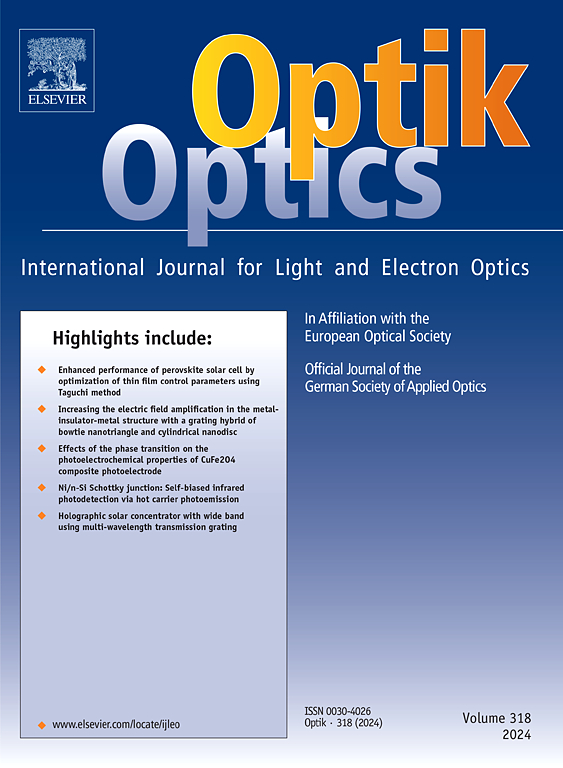Resilient adaptive polarized optical transmission for mitigating atmospheric turbulence in free space optics communication
IF 3.1
3区 物理与天体物理
Q2 Engineering
引用次数: 0
Abstract
Free Space Optical (FSO) communication has gained significant attention as a high-speed data transmission technology due to its ability to leverage light waves for transmitting information through the atmosphere. However, it faces several atmospheric turbulence challenges that can adversely affect its performance, including weather-induced attenuation, polarization-induced fading, polarization mismatches, and spectral efficiency loss. This paper presents the Resilient Adaptive Polarized Optical Transmission (RAPOT) framework, which integrates Adaptive M-ary Differential Quadrature Phase-Shift Keying (AM-DQPSK), Spatial Polarization Multiplexing (SPM), Dynamic Spatial Mode Switching (DSMS), and Polarization-Time Coding (PTC) to enhance modulation, multiplexing, and overall system resilience. AM-DQPSK allows the system to dynamically adjust modulation order based on real-time channel conditions, mitigating the impact of weather-induced attenuation and maintaining reliable communication. SPM increases spectral efficiency by utilizing orthogonally polarized carriers, while also providing polarization diversity to reduce the effects of polarization-induced fading. DSMS enhances robustness by adapting spatial modes to real-time environmental changes, effectively countering polarization mismatches. Finally, PTC encodes data across polarization and time domains, overcoming spectral efficiency loss and providing redundancy for signal recovery in challenging environments. The performance of the RAPOT system is evaluated through extensive experimental simulations and the simulation results for RAPOT system operating at 20 Gbps indicate substantial performance improvements under moderate turbulence conditions. The system achieved a Bit Error Rate (BER) of 10⁻⁵ at Signal to Noise Ratio (SNR) 25, demonstrating robust error performance. The outage probability (OP) is minimized to 0.03, while the link range extended to 2.8 km, showcasing the system's capability to maintain reliable communication even in challenging environments. Additionally, the RAPOT system demonstrated a 25 % increase in spectral efficiency, reaching 8 bits/Hz, compared to conventional systems. These results highlight the RAPOT system's effectiveness in mitigating the challenges posed by atmospheric turbulence and ensuring high-speed FSO communication.
自由空间光通信中缓解大气湍流的弹性自适应偏振光传输
自由空间光通信(FSO)作为一种高速数据传输技术,由于其利用光波通过大气传输信息的能力而获得了极大的关注。然而,它面临着一些大气湍流的挑战,这些挑战可能会对其性能产生不利影响,包括天气引起的衰减、极化引起的衰落、极化不匹配和频谱效率损失。本文提出了弹性自适应偏振光传输(RAPOT)框架,该框架集成了自适应M-ary微分正交相移键控(AM-DQPSK),空间极化多路复用(SPM),动态空间模式切换(DSMS)和极化时间编码(PTC),以增强调制,多路复用和整体系统弹性。AM-DQPSK允许系统根据实时信道条件动态调整调制顺序,减轻天气引起的衰减影响并保持可靠的通信。SPM通过利用正交极化载波提高频谱效率,同时还提供极化分集以减少极化诱导衰落的影响。DSMS通过使空间模式适应实时环境变化来增强鲁棒性,有效地对抗极化不匹配。最后,PTC跨极化和时域对数据进行编码,克服了频谱效率损失,并为具有挑战性的环境中的信号恢复提供了冗余。RAPOT系统的性能通过大量的实验模拟进行了评估,在20 Gbps的速度下,RAPOT系统的模拟结果表明,在中等湍流条件下,RAPOT系统的性能有了实质性的提高。该系统在信噪比(SNR)为25的情况下实现了10⁻5的误码率(BER),显示了稳健的错误性能。中断概率(OP)降至0.03,而链路范围扩展至2.8 公里,显示了系统即使在具有挑战性的环境中也能保持可靠通信的能力。此外,与传统系统相比,RAPOT系统的频谱效率提高了25% %,达到8比特/赫兹。这些结果突出了RAPOT系统在缓解大气湍流带来的挑战和确保高速FSO通信方面的有效性。
本文章由计算机程序翻译,如有差异,请以英文原文为准。
求助全文
约1分钟内获得全文
求助全文
来源期刊

Optik
物理-光学
CiteScore
6.90
自引率
12.90%
发文量
1471
审稿时长
46 days
期刊介绍:
Optik publishes articles on all subjects related to light and electron optics and offers a survey on the state of research and technical development within the following fields:
Optics:
-Optics design, geometrical and beam optics, wave optics-
Optical and micro-optical components, diffractive optics, devices and systems-
Photoelectric and optoelectronic devices-
Optical properties of materials, nonlinear optics, wave propagation and transmission in homogeneous and inhomogeneous materials-
Information optics, image formation and processing, holographic techniques, microscopes and spectrometer techniques, and image analysis-
Optical testing and measuring techniques-
Optical communication and computing-
Physiological optics-
As well as other related topics.
 求助内容:
求助内容: 应助结果提醒方式:
应助结果提醒方式:


